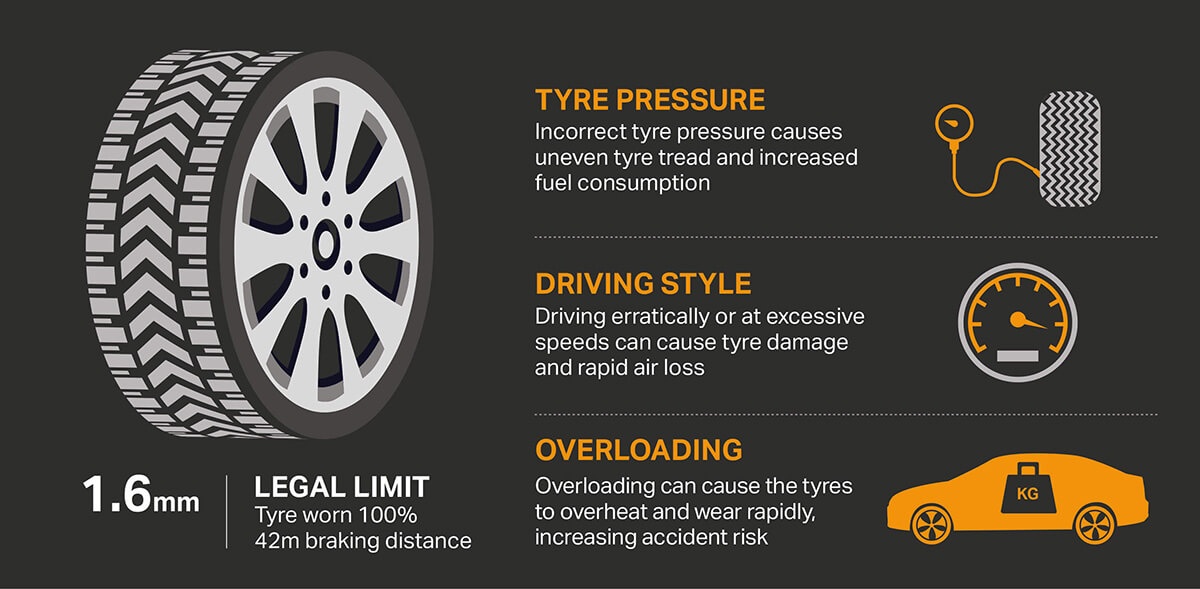A guide to car tyre tread depth and safety
Few parts on a car are as important as our tyres and it’s vital to ensure that your tyre tread depths are at the legal requirement. Here’s everything you need to know about checking your tread depth.

What is tyre tread?
Your tyre's tread is designed to keep the tyre in contact with the road. So, as your tyre wears, its ability to grip the road decreases, meaning longer stopping distances and a higher risk of aquaplaning.
Driving with worn tyres is not only a serious safety risk but a costly one too. In the UK, the fine for bald tyres is £2,500 plus three points on your licence per tyre, so it's really important to check them monthly for any signs of damage or wear.
Minimum legal tread depth
So, what is the minimum tread depth required for car tyres?
While a new car tyre begins life with approximately 8mm of tread, the minimum legal tread depth is 1.6mm. However, most motoring organisations recommend changing your tyres before the tread gets to this level.
Independent research by the Motoring Industry Research Association (MIRA) has shown that tyres with 3mm of tread have an average 25% better performance than those at 1.6mm - which represents an extra 8 metres of stopping distance in wet conditions!
What causes tyre wear?
The typical lifespan of a quality tyre is between three and five years. However, there are many factors that can cause rapid tyre wear, such as:
Incorrect tyre pressure - having over or under-inflated tyres can cause uneven tyre tread. For more information on the impact your tyre pressure has please click here.
Driving style - accelerating and braking harshly will damage your tyres, and may result in rapid air loss. For more information about how this affects your car, please click here.
Overloading - a heavier car can cause your tyres to overheat, increasing the risk of an accident. Please click here for more information.
Alignment - your tyres will wear unevenly if your wheels are misaligned. For more information on wheel balancing and tracking please click here.
How to check your tyre tread depth
You can check how close you are to the legal limit on all tyres by checking the tread wear indicators:
These indicators are small raised areas at the bottom of the grooves. Once the surface of the tread rubber is level with these raised areas, the tyre tread depth is approaching the legal limit of 1.6mm and you should have your tyres checked and replaced.
Tyre tread depth checker
If you’re unsure whether your tyre tread depths are at a safe level, you can use a handy tyre tread depth gauge to help. These devices will give you an accurate measurement for that extra peace of mind.
Halfords Free Tyre Check
Want help checking your tread depths are at a safe level? Book a Free Tyre Check and one of our trained technicians will not only check your tyre tread depth but will also carry out a pressure check and inspect for wear and damage.
If any problems are found during the inspection, one of our technicians will advise you on what can be done to correct the issue.
It’s the easiest way to check that your tyres are up to the task!
Replacing tyres
If the tread depth on your tyres is at or below 1.6mm, you will need to replace your tyres – although we’d advise that you change them before they get to this level.
Here at Halfords, we have a wide range of tyres to choose from, with a choice of the best brands. If you’re unsure what tyres are best for your vehicle, our Car Tyres Buyers Guide will help.
We also offer same day fitting in many of our garages, and you can find out more here. Or, why not make life easier and let us come to you? Our Halfords Mobile Experts can change your tyres at home or at work, and at a time that is convenient for you.
So, what are you waiting for? You can book your tyre fitting through our Mobile Experts here.
For further advice on car tyres, head over to our tyre help and advice page.

